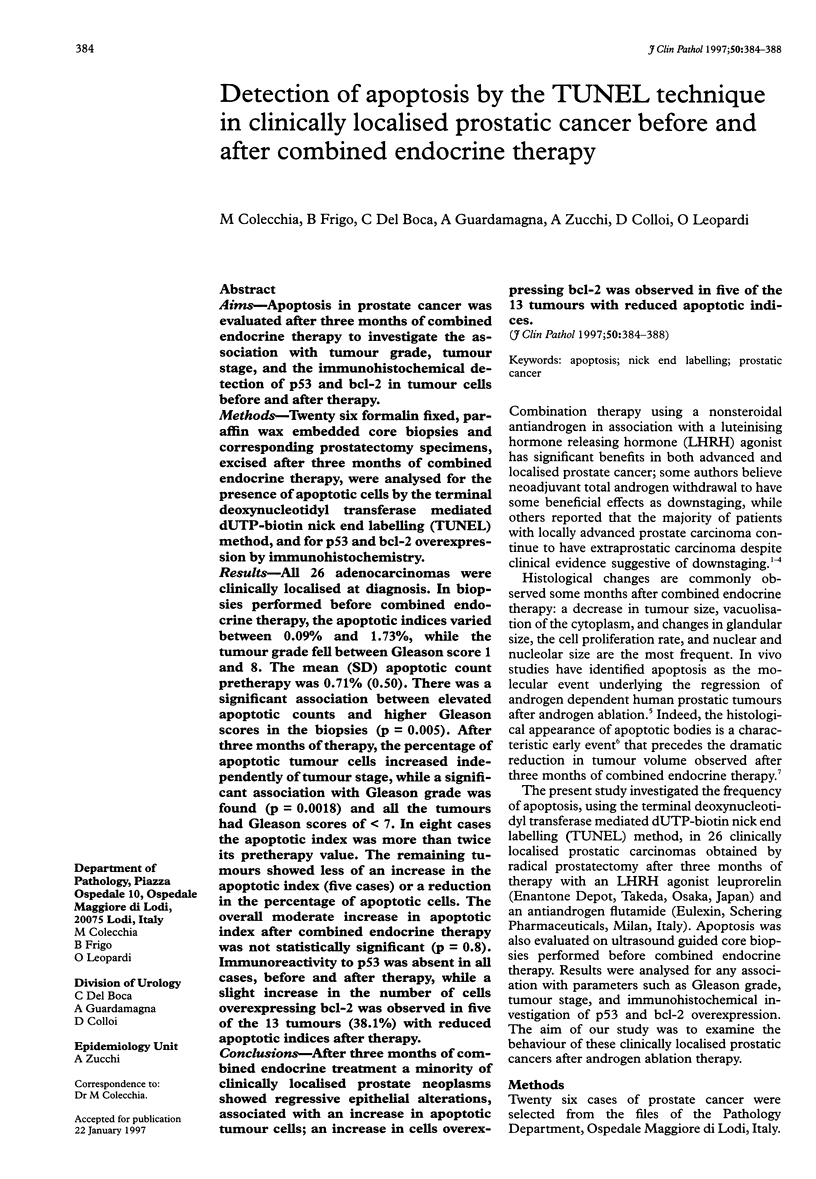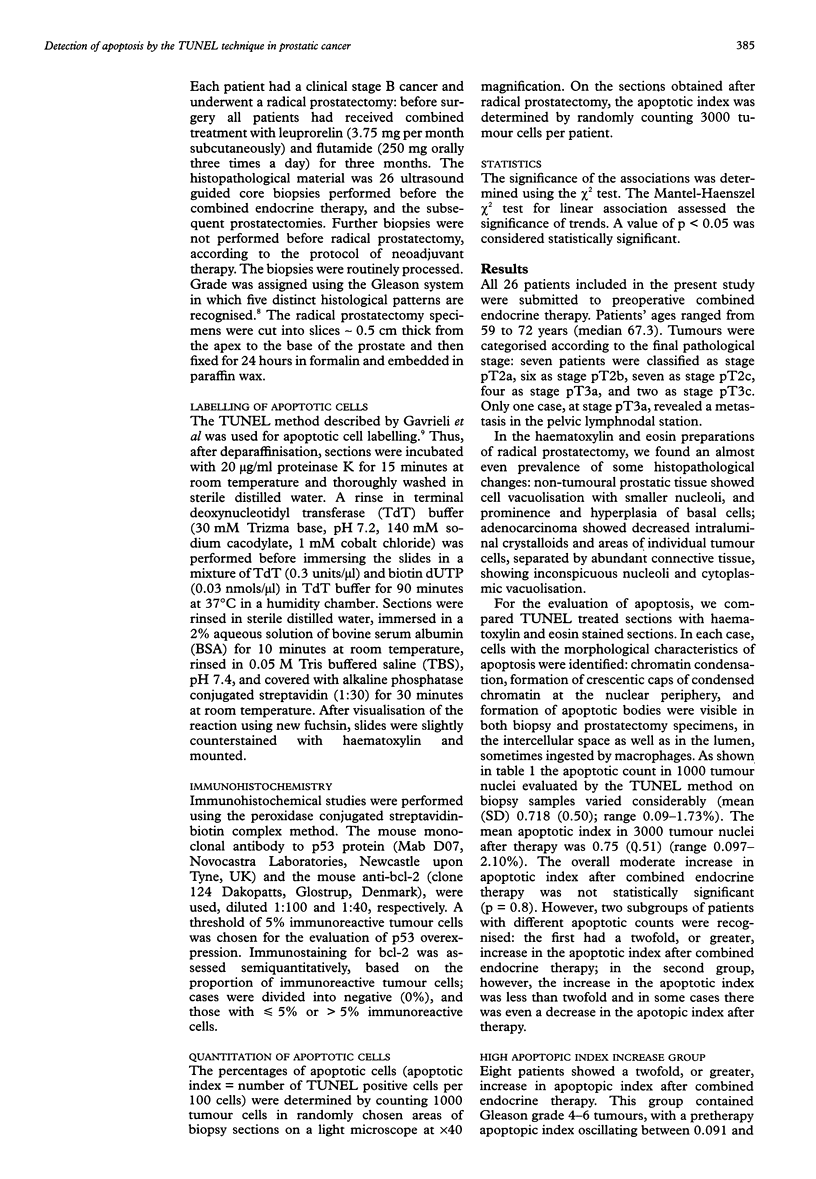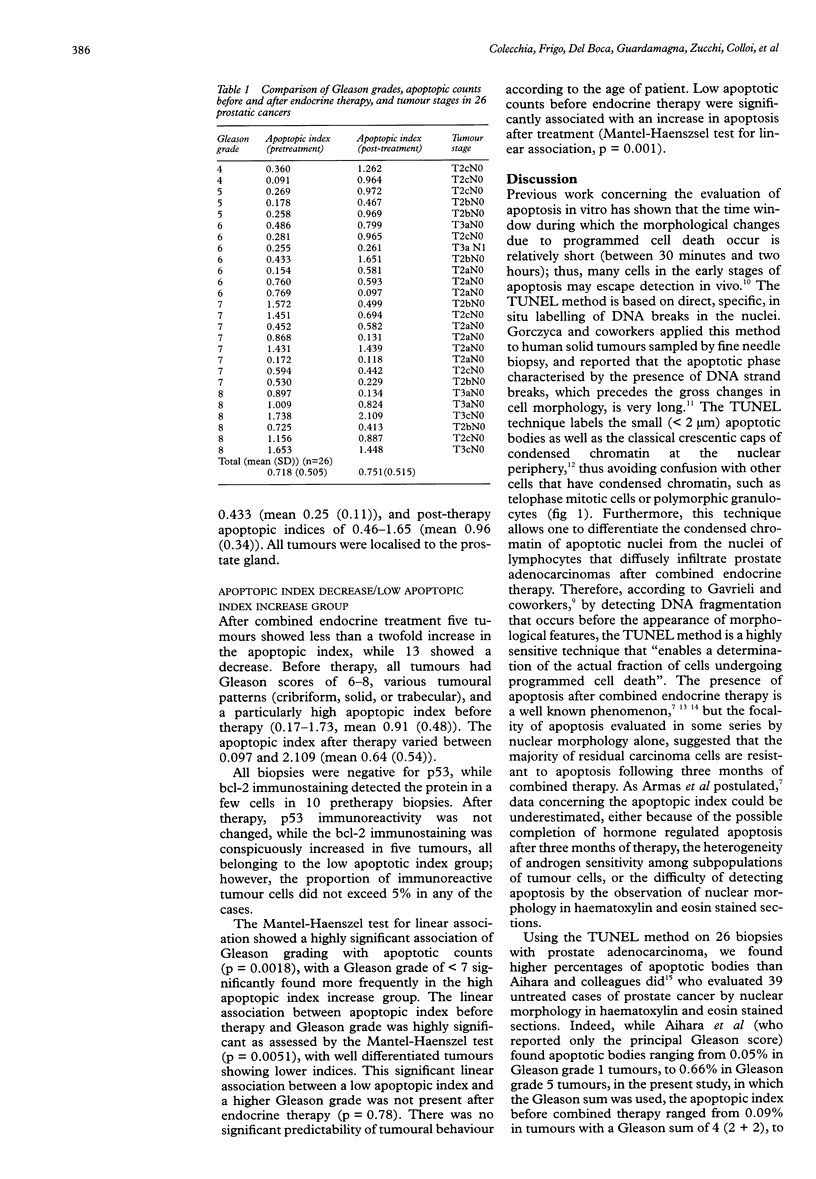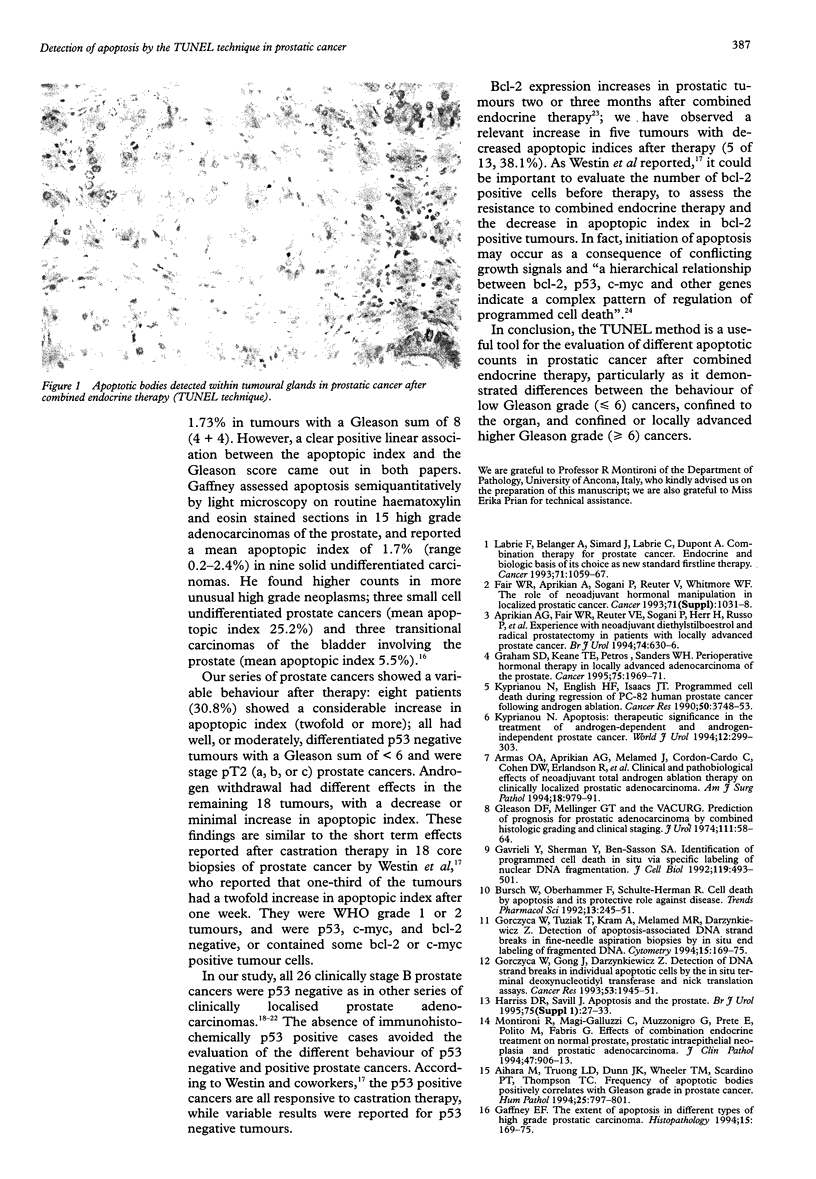Abstract
AIMS: Apoptosis in prostate cancer was evaluated after three months of combined endocrine therapy to investigate the association with tumour grade, tumour stage, and the immunohistochemical detection of p53 and bcl-2 in tumour cells before and after therapy. METHODS: Twenty six formalin fixed, paraffin wax embedded core biopsies and corresponding prostatectomy specimens, excised after three months of combined endocrine therapy, were analysed for the presence of apoptotic cells by the terminal deoxynucleotidyl transferase mediated dUTP-biotin nick end labelling (TUNEL) method, and for p53 and bcl-2 overexpression by immunohistochemistry. RESULTS: All 26 adenocarcinomas were clinically localised at diagnosis. In biopsies performed before combined endocrine therapy, the apoptotic indices varied between 0.09% and 1.73%, while the tumour grade fell between Gleason score 1 and 8. The mean (SD) apoptotic count pretherapy was 0.71% (0.50). There was a significant association between elevated apoptotic counts and higher Gleason scores in the biopsies (p = 0.005). After three months of therapy, the percentage of apoptotic tumour cells increased independently of tumour stage, while a significant association with Gleason grade was found (p = 0.0018) and all the tumours had Gleason scores of < 7. In eight cases the apoptotic index was more than twice its pretherapy value. The remaining tumours showed less of an increase in the apoptotic index (five cases) or a reduction in the percentage of apoptotic cells. The overall moderate increase in apoptotic index after combined endocrine therapy was not statistically significant (p = 0.8). Immunoreactivity to p53 was absent in all cases, before and after therapy, while a slight increase in the number of cells overexpressing bcl-2 was observed in five of the 13 tumours (38.1%) with reduced apoptotic indices after therapy. CONCLUSIONS: After three months of combined endocrine treatment a minority of clinically localised prostate neoplasms showed regressive epithelial alterations, associated with an increase in apoptotic tumour cells; an increase in cells overexpressing bcl-2 was observed in five of the 13 tumours with reduced apoptotic indices.
Full text
PDF




Images in this article
Selected References
These references are in PubMed. This may not be the complete list of references from this article.
- Aihara M., Truong L. D., Dunn J. K., Wheeler T. M., Scardino P. T., Thompson T. C. Frequency of apoptotic bodies positively correlates with Gleason grade in prostate cancer. Hum Pathol. 1994 Aug;25(8):797–801. doi: 10.1016/0046-8177(94)90249-6. [DOI] [PubMed] [Google Scholar]
- Aprikian A. G., Fair W. R., Reuter V. E., Sogani P., Herr H., Russo P., Sheinfeld J. Experience with neoadjuvant diethylstilboestrol and radical prostatectomy in patients with locally advanced prostate cancer. Br J Urol. 1994 Nov;74(5):630–636. doi: 10.1111/j.1464-410x.1994.tb09196.x. [DOI] [PubMed] [Google Scholar]
- Aprikian A. G., Sarkis A. S., Fair W. R., Zhang Z. F., Fuks Z., Cordon-Cardo C. Immunohistochemical determination of p53 protein nuclear accumulation in prostatic adenocarcinoma. J Urol. 1994 May;151(5):1276–1280. doi: 10.1016/s0022-5347(17)35231-x. [DOI] [PubMed] [Google Scholar]
- Armas O. A., Aprikian A. G., Melamed J., Cordon-Cardo C., Cohen D. W., Erlandson R., Fair W. R., Reuter V. E. Clinical and pathobiological effects of neoadjuvant total androgen ablation therapy on clinically localized prostatic adenocarcinoma. Am J Surg Pathol. 1994 Oct;18(10):979–991. doi: 10.1097/00000478-199410000-00002. [DOI] [PubMed] [Google Scholar]
- Bursch W., Oberhammer F., Schulte-Hermann R. Cell death by apoptosis and its protective role against disease. Trends Pharmacol Sci. 1992 Jun;13(6):245–251. doi: 10.1016/0165-6147(92)90077-j. [DOI] [PubMed] [Google Scholar]
- Colombel M., Symmans F., Gil S., O'Toole K. M., Chopin D., Benson M., Olsson C. A., Korsmeyer S., Buttyan R. Detection of the apoptosis-suppressing oncoprotein bc1-2 in hormone-refractory human prostate cancers. Am J Pathol. 1993 Aug;143(2):390–400. [PMC free article] [PubMed] [Google Scholar]
- Fair W. R., Aprikian A., Sogani P., Reuter V., Whitmore W. F., Jr The role of neoadjuvant hormonal manipulation in localized prostatic cancer. Cancer. 1993 Feb 1;71(3 Suppl):1031–1038. doi: 10.1002/1097-0142(19930201)71:3+<1031::aid-cncr2820711422>3.0.co;2-7. [DOI] [PubMed] [Google Scholar]
- Gavrieli Y., Sherman Y., Ben-Sasson S. A. Identification of programmed cell death in situ via specific labeling of nuclear DNA fragmentation. J Cell Biol. 1992 Nov;119(3):493–501. doi: 10.1083/jcb.119.3.493. [DOI] [PMC free article] [PubMed] [Google Scholar]
- Gleason D. F., Mellinger G. T. Prediction of prognosis for prostatic adenocarcinoma by combined histological grading and clinical staging. J Urol. 1974 Jan;111(1):58–64. doi: 10.1016/s0022-5347(17)59889-4. [DOI] [PubMed] [Google Scholar]
- Gorczyca W., Gong J., Darzynkiewicz Z. Detection of DNA strand breaks in individual apoptotic cells by the in situ terminal deoxynucleotidyl transferase and nick translation assays. Cancer Res. 1993 Apr 15;53(8):1945–1951. [PubMed] [Google Scholar]
- Gorczyca W., Tuziak T., Kram A., Melamed M. R., Darzynkiewicz Z. Detection of apoptosis-associated DNA strand breaks in fine-needle aspiration biopsies by in situ end labeling of fragmented DNA. Cytometry. 1994 Feb 1;15(2):169–175. doi: 10.1002/cyto.990150211. [DOI] [PubMed] [Google Scholar]
- Hall M. C., Navone N. M., Troncoso P., Pollack A., Zagars G. K., von Eschenbach A. C., Conti C. J., Chung L. W. Frequency and characterization of p53 mutations in clinically localized prostate cancer. Urology. 1995 Mar;45(3):470–475. doi: 10.1016/s0090-4295(99)80018-1. [DOI] [PubMed] [Google Scholar]
- Harriss D. R., Savill J. Apoptosis and the prostate. Br J Urol. 1995 Jun;75 (Suppl 1):27–33. [PubMed] [Google Scholar]
- Ittmann M., Wieczorek R., Heller P., Dave A., Provet J., Krolewski J. Alterations in the p53 and MDM-2 genes are infrequent in clinically localized, stage B prostate adenocarcinomas. Am J Pathol. 1994 Aug;145(2):287–293. [PMC free article] [PubMed] [Google Scholar]
- Kyprianou N. Apoptosis: therapeutic significance in the treatment of androgen-dependent and androgen-independent prostate cancer. World J Urol. 1994;12(6):299–303. doi: 10.1007/BF00184107. [DOI] [PubMed] [Google Scholar]
- Kyprianou N., English H. F., Isaacs J. T. Programmed cell death during regression of PC-82 human prostate cancer following androgen ablation. Cancer Res. 1990 Jun 15;50(12):3748–3753. [PubMed] [Google Scholar]
- Labrie F., Belanger A., Simard J., Labrie C., Dupont A. Combination therapy for prostate cancer. Endocrine and biologic basis of its choice as new standard first-line therapy. Cancer. 1993 Feb 1;71(3 Suppl):1059–1067. doi: 10.1002/1097-0142(19930201)71:3+<1059::aid-cncr2820711426>3.0.co;2-6. [DOI] [PubMed] [Google Scholar]
- Mellon K., Thompson S., Charlton R. G., Marsh C., Robinson M., Lane D. P., Harris A. L., Horne C. H., Neal D. E. p53, c-erbB-2 and the epidermal growth factor receptor in the benign and malignant prostate. J Urol. 1992 Feb;147(2):496–499. doi: 10.1016/s0022-5347(17)37287-7. [DOI] [PubMed] [Google Scholar]
- Navone N. M., Troncoso P., Pisters L. L., Goodrow T. L., Palmer J. L., Nichols W. W., von Eschenbach A. C., Conti C. J. p53 protein accumulation and gene mutation in the progression of human prostate carcinoma. J Natl Cancer Inst. 1993 Oct 20;85(20):1657–1669. doi: 10.1093/jnci/85.20.1657. [DOI] [PubMed] [Google Scholar]
- Stewart B. W. Mechanisms of apoptosis: integration of genetic, biochemical, and cellular indicators. J Natl Cancer Inst. 1994 Sep 7;86(17):1286–1296. doi: 10.1093/jnci/86.17.1286. [DOI] [PubMed] [Google Scholar]
- Westin P., Stattin P., Damber J. E., Bergh A. Castration therapy rapidly induces apoptosis in a minority and decreases cell proliferation in a majority of human prostatic tumors. Am J Pathol. 1995 Jun;146(6):1368–1375. [PMC free article] [PubMed] [Google Scholar]



